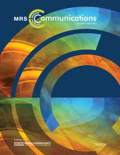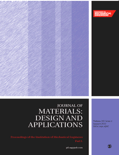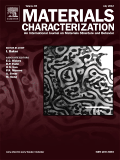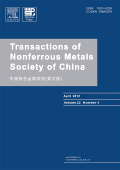
Journal of Metals Materials and Minerals
Scope & Guideline
Catalyzing Discoveries in Metals, Ceramics, and Biomaterials
Introduction
Aims and Scopes
- Materials Characterization and Analysis:
The journal emphasizes the characterization and analysis of materials, including their structural, mechanical, thermal, and electrical properties, using various techniques like spectroscopy, microscopy, and computational modeling. - Innovative Material Processing Techniques:
Research on novel processing techniques such as additive manufacturing, advanced welding, and nanomaterial synthesis is a core focus, highlighting how these methods can enhance material performance and sustainability. - Sustainable Materials Science:
The journal promotes studies on sustainable materials, including recycling, bio-based materials, and eco-friendly production methods, reflecting the growing importance of sustainability in materials science. - Applications of Materials in Technology:
It covers a wide range of applications for metals and materials in technology, including energy storage, sensors, electronics, and structural applications, showcasing the practical implications of research findings. - Interdisciplinary Research:
The journal encourages interdisciplinary approaches, integrating concepts from chemistry, physics, biology, and engineering to solve complex materials-related challenges.
Trending and Emerging
- Nanomaterials and Nanocomposites:
There is a growing trend in the synthesis and application of nanomaterials and nanocomposites, emphasizing their unique properties and potential for enhancing the performance of traditional materials in various applications. - Energy Storage and Conversion Materials:
Research on materials for energy storage, such as batteries and supercapacitors, is on the rise, driven by the demand for sustainable energy solutions and advancements in materials chemistry. - Smart and Functional Materials:
Emerging studies focus on the development of smart materials that respond to environmental stimuli, including self-healing materials and shape-memory alloys, showcasing their potential in innovative applications. - Eco-friendly and Biodegradable Materials:
The journal is increasingly publishing research on eco-friendly and biodegradable materials, reflecting a significant trend towards sustainability and the reduction of environmental impact in materials engineering. - Advanced Characterization Techniques:
There is an increasing emphasis on novel characterization techniques, such as in-situ analysis and advanced microscopy, to better understand material properties and behaviors at the micro and nanoscale.
Declining or Waning
- Traditional Metallic Alloys:
Research focused solely on traditional metallic alloys has seen a decline, as the field shifts towards more innovative materials such as composites, nanomaterials, and alloys with unique properties. - Conventional Manufacturing Processes:
There is a waning interest in conventional manufacturing processes, as newer additive manufacturing and processing techniques are becoming more prevalent, leading to a reduction in publications on traditional methods. - Basic Materials Science without Application Context:
Studies that focus on the basic science of materials without a clear application context are becoming less common, as the journal increasingly favors research that demonstrates practical applications and societal relevance. - Single-Discipline Studies:
Research papers that do not incorporate interdisciplinary approaches are seeing reduced publication opportunities, reflecting a broader trend towards collaborative and multi-disciplinary research efforts.
Similar Journals

MATERIALS SCIENCE AND TECHNOLOGY
Unveiling the Future of Materials TechnologyMATERIALS SCIENCE AND TECHNOLOGY is a leading journal published by SAGE PUBLICATIONS INC, focusing on the interdisciplinary advancements in the field of materials science. Since its inception in 1984, the journal has provided a platform for researchers and industry professionals to present innovative findings through rigorous peer-reviewed articles. The journal holds a commendable impact factor and categorizes itself within the prestigious Q2 rank in various domains such as Condensed Matter Physics, Materials Science, Mechanical Engineering, and Mechanics of Materials according to the 2023 Quartiles. With no Open Access option, it primarily serves as a repository for in-depth studies and advancements that push the boundaries of materials engineering and application. Located in the United Kingdom, at 2455 TELLER RD, THOUSAND OAKS, CA 91320, the journal continues to attract a global readership, making it indispensable for academics, researchers, and students who aim to stay at the forefront of materials innovation.

Materials Letters-X
Connecting Researchers Through Open Access ExcellenceMaterials Letters-X, published by ELSEVIER, is an esteemed open-access journal dedicated to the rapid communication of research in the fields of Condensed Matter Physics, Materials Science, Mechanical Engineering, and Mechanics of Materials. Launched in 2019, this journal has quickly established itself within the academic community, achieving Q3 quartile rankings in several categories according to the 2023 metrics. The journal's impactful contributions are reflected in its Scopus rankings, notably within Mechanical Engineering (Rank #308) and Mechanics of Materials (Rank #199). The open-access model promotes widespread dissemination and accessibility, ensuring that cutting-edge advancements in material science are readily available to researchers, professionals, and students worldwide. As it continues to grow, Materials Letters-X aims to inspire innovation and collaboration across disciplines, making it a pivotal resource for those engaged in material research and applications.

MATERIALS SCIENCE-POLAND
Transforming Ideas into Material BreakthroughsMATERIALS SCIENCE-POLAND, published by SCIENDO, is an esteemed open access journal dedicated to the rapidly evolving field of materials science. Since its inception in 2002 and transitioning to an open access model in 2015, the journal has been a vital platform for researchers and professionals to disseminate their findings and contribute to the scientific community. With an ISSN of 2083-134X and an E-ISSN of 2083-134X, it spans a comprehensive range of disciplines, focusing on condensed matter physics, materials science, and mechanical engineering among others. In the 2023 rankings, it holds a position in the Q4 and Q3 quartiles across various categories, showcasing its relevance and ongoing contribution to these fields. Researchers benefit from its accessibility, enabling wider reach and engagement with contemporary topics in material innovation and applications. As the journal continues to evolve until 2024, it remains a cornerstone for scholars looking to advance their knowledge and research in materials science.

Ceramics-Switzerland
Unlocking New Horizons in Ceramics TechnologyCeramics-Switzerland is a prominent open-access journal published by MDPI, dedicated to advancing knowledge in the field of ceramics and materials science. Established in 2018, this journal serves as a vital platform for researchers, professionals, and students to disseminate innovative research and technology in ceramics and composites. With an impressive impact factor and a categorized ranking of Q2 in Ceramics and Composites and Q3 in Miscellaneous Materials Science for 2023, Ceramics-Switzerland signifies its growing influence and contribution to the scientific community. The journal is indexed in Scopus, where it boasts a rank that highlights its competitive standing within the field. Being an open access journal enables the wide distribution of research findings, fostering greater collaboration and knowledge sharing among scholars and industry experts globally.

MRS Communications
Exploring the frontiers of materials through peer-reviewed excellence.MRS Communications is a prominent academic journal published by Springer Heidelberg, focusing on the multidisciplinary field of materials science. With ISSN 2159-6859 and E-ISSN 2159-6867, this journal has been a valuable platform for disseminating cutting-edge research since its inception in 2011. Operating from its esteemed headquarters in Heidelberg, Germany, it aims to foster collaboration and innovation among researchers and practitioners by publishing high-quality, peer-reviewed articles. Holding a Q3 ranking in the Materials Science (Miscellaneous) category, and currently positioned at the 37th percentile in the general materials science field, MRS Communications is dedicated to advancing the understanding of materials through interdisciplinary studies. The journal offers researchers an opportunity to share insights that bridge theoretical knowledge with practical applications, contributing significantly to the global materials science community. As an essential resource for researchers, professionals, and students alike, we invite you to explore the latest advancements and discussions in materials science through this influential publication.

Materiali in Tehnologije
Bridging Knowledge in Materials EngineeringMateriali in Tehnologije is a distinguished peer-reviewed journal dedicated to the field of materials science, focusing specifically on metals and polymers. Published by the Institute for Metals and Materials Technology in Slovenia, this open-access journal has been at the forefront of disseminating research findings and innovative technologies since 2000. With a current impact factor that reflects its increasing visibility in the academic community, Materiali in Tehnologije serves as an invaluable resource for researchers, professionals, and students alike, encompassing a wide array of studies in the categories of Metals and Alloys, as well as Polymers and Plastics. The journal is indexed in Scopus, highlighting its relevance and contribution to the field, particularly with its ranks of Q3 in Metals and Alloys and Q4 in Polymers and Plastics. As it converges towards 2024, Materiali in Tehnologije continues to be a pivotal platform for knowledge exchange, encouraging advancements in materials research and technology.

PROCEEDINGS OF THE INSTITUTION OF MECHANICAL ENGINEERS PART L-JOURNAL OF MATERIALS-DESIGN AND APPLICATIONS
Advancing Innovation in Materials Design and EngineeringPROCEEDINGS OF THE INSTITUTION OF MECHANICAL ENGINEERS PART L-JOURNAL OF MATERIALS-DESIGN AND APPLICATIONS is a prestigious academic journal published by SAGE PUBLICATIONS LTD, focusing on the dynamic fields of mechanical engineering and materials science. With an impressive impact factor reflective of its rigorous scholarly contributions, this journal serves as a vital platform for the dissemination of innovative research and practical applications in materials design and engineering processes. Since its inception in 1999 and continuing through 2024, it has maintained a robust reputation, achieving a Q2 ranking in both Materials Science (miscellaneous) and Mechanical Engineering categories, as well as commendable Scopus ranks that place it in the top percentiles of its fields. Located in the United Kingdom, the journal encourages submissions from researchers and professionals who are seeking to advance their understanding of materials applications while fostering interdisciplinary collaboration. Although it currently operates under traditional access terms, the journal prioritizes impactful research that addresses contemporary challenges in design and manufacturing, ensuring that it remains a must-read for anyone invested in the innovations shaping our technological landscape.

Composites Part C: Open Access
Advancing Knowledge in Composite MaterialsComposites Part C: Open Access, an esteemed journal published by Elsevier, is at the forefront of research in the fields of Ceramics and Composites, Mechanical Engineering, and Mechanics of Materials. Launched in 2020, this fully open-access journal facilitates unparalleled access to significant advancements in composite materials, ensuring that research findings are disseminated widely and freely throughout the global academic community. With an impressive Q1 ranking across multiple related categories and robust placements in Scopus rankings, specifically #78 in Mechanical Engineering and #24 in Materials Science, the journal serves as a vital platform for researchers, professionals, and students to publish their work and engage with cutting-edge studies. It aims to foster innovation and collaboration in the development and application of composite materials and their technologies, making it an indispensable resource for anyone invested in these dynamic fields.

MATERIALS CHARACTERIZATION
Exploring the Depths of Materials EngineeringMATERIALS CHARACTERIZATION is a leading international journal dedicated to the advancement of knowledge in the field of materials science and engineering. Published by Elsevier Science Inc, this esteemed journal has been disseminating vital research since 1970 and continues to be essential for scholars and industry professionals alike. With an impressive impact reflected in its Q1 quartile rankings across several categories—including Condensed Matter Physics, Materials Science, Mechanical Engineering, and Mechanics of Materials—MATERIALS CHARACTERIZATION stands out as a premier outlet for innovative studies and technical advancements. Researchers can access a wealth of peer-reviewed articles that explore properties, characterization techniques, and applications of materials, fostering interdisciplinary collaboration. With a commitment to high-quality research and comprehensive review processes, the journal plays a crucial role in shaping the future of materials science, making it an invaluable resource for anyone invested in this dynamic field.

TRANSACTIONS OF NONFERROUS METALS SOCIETY OF CHINA
Driving progress in nonferrous metals research and applications.TRANSACTIONS OF NONFERROUS METALS SOCIETY OF CHINA, published by Elsevier, is a premier academic journal that serves as a vital platform for researchers and professionals specializing in materials science, condensed matter physics, geotechnical engineering, and engineering geology. Established in 1994, this esteemed publication has maintained a robust focus on the latest developments in the nonferrous metals sector, reflecting its significant impact in the field with a Q1 categorization across multiple disciplines. With impressive Scopus rankings—placing it in the top 20% of journals in relevant categories—this journal is recognized for its quality and rigor, providing critical insights into metals and alloys, materials chemistry, and their applications. The non-open access format ensures a dedicated readership among professionals and academics seeking substantial and authoritative research articles. By fostering knowledge exchange, the journal strives to advance the understanding and application of nonferrous metals, making it an essential resource for anyone involved in material innovations and engineering solutions.